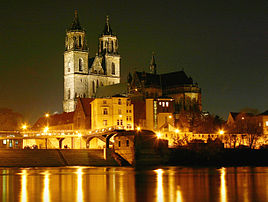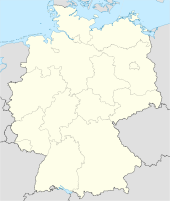- Magdeburg
-
This article is about the German city. For other uses, see Magdeburg (disambiguation).
Magdeburg The town's symbol - Cathedral of Magdeburg 
Coordinates 52°8′0″N 11°37′0″E / 52.133333°N 11.616667°ECoordinates: 52°8′0″N 11°37′0″E / 52.133333°N 11.616667°E Administration Country Germany State Saxony-Anhalt District Urban district City subdivisions 40 boroughs Lord Mayor Lutz Trümper (SPD) Basic statistics Area 200.95 km2 (77.59 sq mi) Elevation 43 m (141 ft) Population 231,525 (31 December 2010)[1] - Density 1,152 /km2 (2,984 /sq mi) Other information Time zone CET/CEST (UTC+1/+2) Licence plate MD Postal codes 39104-39130 Area code 0391 Website www.magdeburg.de Magdeburg (German pronunciation: [ˈmakdəbʊrk]; local: [ˈmaxdəbʊɐ̯ç]; Low Saxon: Meideborg, [ˈmaˑɪdebɔɐx]), is the largest city[2] and the capital city of the Bundesland of Saxony-Anhalt, Germany. Magdeburg is situated on the Elbe River and was one of the most important medieval cities of Europe.
Emperor Otto I, the first Holy Roman Emperor, lived for most of his reign in the town and was buried in the cathedral after his death. Magdeburg's version of German town law, known as Magdeburg rights, spread throughout Central and Eastern Europe. The city is also well known for the 1631 Sack of Magdeburg, which hardened Protestant resistance during the Thirty Years' War.
Magdeburg is the site of two universities, the Otto-von-Guericke University and the Magdeburg-Stendal University of Applied Sciences.
Nowadays Magdeburg is a traffic junction as well as an industrial and trading centre. The production of chemical products, steel, paper and textiles are of particular economic significance, along with Mechanical engineering and plant engineering, Ecotechnology and life-cycle management, Health management and Logistics. Along with ten other cities in Saxony-Anhalt, Saxony and Thuringia, Magdeburg is a member of the Central German Metropolitan Region.
In 2005 Magdeburg celebrated its 1200th anniversary.
Contents
History
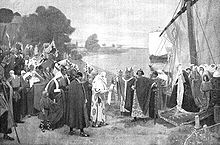 Kaiser Otto I and his wife Edith arrive near Magdeburg, in a 19th-century painting
Kaiser Otto I and his wife Edith arrive near Magdeburg, in a 19th-century painting
Founded by Charlemagne in 805 as Magadoburg (probably from Old High German magado for big, mighty and burga for fortress'[3]), the town was fortified in 919 by King Henry I the Fowler against the Magyars and Slavs. In 929 the city went to Edward the Elder's daughter Edith, through her marriage to Henry's son Otto I, as a Morgengabe — a Germanic customary gift received by the new bride from the groom and his family after the wedding night. Edith loved the town and often lived there; at her death she was buried in the crypt of the Benedictine abbey of Saint Maurice, later rebuilt as the cathedral. In 937, Magdeburg was the seat of a royal assembly. Otto I also continually returned to it and was also buried in the cathedral. He granted the abbey the right to income from various tithes and to corvée labour from the surrounding countryside.
The Archbishopric of Magdeburg was founded in 968 at the synod of Ravenna; Adalbert of Magdeburg was consecrated as its first archbishop. The archbishopric under Tilly included the bishoprics of Havelberg, Brandenburg, Merseburg, Meissen, and Zeitz-Naumburg. The archbishops played a prominent role in the German colonization of the Slavic lands east of the Elbe river.
In 1035 Magdeburg received a patent giving the city the right to hold trade exhibitions and conventions, which form the basis of the later family of city laws known as the Magdeburg rights. These laws were adopted and modified throughout Central and Eastern Europe. Visitors from many countries began to trade with Magdeburg.
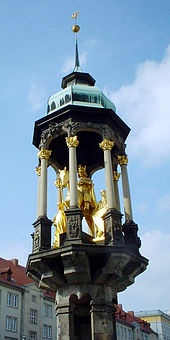 Magdeburger Reiter, 1240, the first equestrian statue north of the Alps
Magdeburger Reiter, 1240, the first equestrian statue north of the Alps
In the 13th century, Magdeburg became a member of the Hanseatic League. With more than 20,000 inhabitants Magdeburg was one of the largest cities in the Holy Roman Empire. The town had an active maritime commerce on the west (towards Flanders), with the countries of the North Sea, and maintained traffic and communication with the interior (for example Brunswick). The citizens constantly struggled against the archbishop, becoming nearly independent from him by the end of the 15th century.
In 1524 Martin Luther was called to Magdeburg, where he preached and caused the city's defection from Catholicism. The Protestant Reformation had quickly found adherents in the city, where Luther had been a schoolboy. Emperor Charles V repeatedly outlawed the unruly town, which had joined the Alliance of Torgau and the Schmalkaldic League. Because it had not accepted the Augsburg Interim (1548), the city, by the emperor's commands, was besieged (1550–1551) by Maurice, Elector of Saxony, but it retained its independence. The rule of the archbishop was replaced by that of various administrators belonging to Protestant dynasties. In the following years Magdeburg gained a reputation as a stronghold of Protestantism and became the first major city to publish the writings of Luther. In Magdeburg, Matthias Flacius and his companions wrote their anti-Catholic pamphlets and the Magdeburg Centuries, in which they argued that the Roman Catholic Church had become the kingdom of the Anti-Christ.
In 1631, during the Thirty Years' War, imperial troops under Johann Tserclaes, Count of Tilly, stormed the city and committed a massacre, killing about 20,000 inhabitants and burning the town in the sack of Magdeburg. The city had withstood a first siege in 1629 by Albrecht von Wallenstein. After the war, a population of only 400 remained. According to the Peace of Westphalia (1648), Magdeburg was assigned to Brandenburg-Prussia after the death of the current administrator, August of Saxe-Weissenfels, as the semi-autonomous Duchy of Magdeburg; this occurred in 1680.
In the course of the Napoleonic Wars, the fortress surrendered to French troops in 1806. The city was annexed to the French-controlled Kingdom of Westphalia in the 1807 Treaty of Tilsit. King Jérôme appointed Count Heinrich von Blumenthal as mayor. In 1815, after the Napoleonic Wars, Magdeburg was made the capital of the new Prussian Province of Saxony. In 1912, the old fortress was dismantled, and in 1908, the municipality Rothensee became part of Magdeburg,
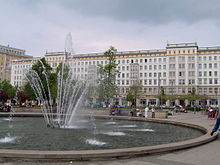 Magdeburg's centre has a number of Stalinist neo-classicist buildings.
Magdeburg's centre has a number of Stalinist neo-classicist buildings.
Near the end of World War II, the city of about 340,000 became capital of the Province of Magdeburg. The Magdeburg/Rothensee plant that produced synthetic oil from lignite coal was a target of the Oil Campaign of World War II. The impressive Gründerzeit suburbs north of the city, called the Nordfront, were destroyed as well as the city's main street with its Baroque buildings. Post-war the area was part of the Soviet Zone of Occupation and many of the remaining pre-World War II city buildings were destroyed, with only a few buildings near the cathedral restored to their pre-war state. Prior to the reunification of Germany, many surviving Gründerzeit buildings were left uninhabited and, after years of degradation, waiting for demolition. From 1949 on until German reunification on 3 October 1990, Magdeburg belonged to the German Democratic Republic.
In 1990 Magdeburg became the capital of the new state of Saxony-Anhalt within reunified Germany. The city centre was rebuilt almost exclusively in a modern style.
Main sights
 Interior of the Cathedral of Magdeburg, looking towards the grave of Otto I
Interior of the Cathedral of Magdeburg, looking towards the grave of Otto I
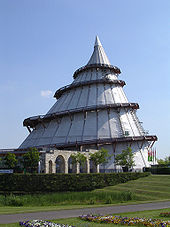 The Jahrtausendturm (English: millennium tower)
The Jahrtausendturm (English: millennium tower)
Cathedral
Main article: Cathedral of MagdeburgOne of Magdeburg's most impressive buildings is the Lutheran Cathedral of Saints Catherine and Maurice with a height of 104 m (341.21 ft), making it the highest church building of eastern Germany. It is notable for its beautiful and unique sculptures, especially the "Twelve Virgins" at the Northern Gate, the depictions of Otto I the Great and his wife Editha as well as the statues of St Maurice and St Catherine. The predecessor of the cathedral was a church built in 937 within an abbey, called St. Maurice. Emperor Otto I the Great was buried here beside his wife in 973. St. Maurice burnt to ashes in 1207. The exact location of that church remained unknown for a long time. The foundations were rediscovered in May 2003, revealing a building 80 m (262.47 ft) long and 41 m (134.51 ft) wide.
The construction of the new church lasted 300 years. The cathedral of Saints Catherine and Maurice was the first Gothic church building in Germany. The building of the steeples was completed as late as 1520.
While the cathedral was virtually the only building to survive the massacres of the Thirty Years' War, it nevertheless suffered damage in World War II. It was soon rebuilt and completed in 1955.
The square in front of the cathedral (sometimes called the Neuer Markt, or "new marketplace") was occupied by an imperial palace (Kaiserpfalz), which was destroyed in the fire of 1207. The stones from the ruin were used for the building of the cathedral. The presumed remains of the palace were excavated in the 1960s.
Other sights
- Unser Lieben Frauen Monastery (Our Lady), 11th century, containing the church of St. Mary. Today a museum for Modern Art. Home of the National Collection of Small Art Statues of the GDR (Nationale Sammlung Kleinkunstplastiken der DDR).
- The Magdeburger Reiter ("Magdeburg equestrian", 1240), the first equestrian sculpture north of the alps. It probably depicts the Emperor Otto I.
- Town hall (1698). This building had stood on the market place since the 13th century, but it was destroyed in the Thirty Years' War; the new town hall was built in a Renaissance style influenced by Dutch architecture. It was renovated and re-opened in Oct 2005.
- Landtag; the seat of the government of Saxony-Anhalt with its Baroque façade built in 1724.
- monuments depicting Otto von Guericke (1907), Eike von Repkow and Friedrich Wilhelm von Steuben.
- Ruins of the greatest fortress of the former Kingdom of Prussia.
- Rotehorn-Park.
- Elbauenpark containing the highest wooden structure in Germany.
- St. John Church (Johanniskirche)
- The Gruson-Gewächshäuser, a botanical garden within a greenhouse complex
- The Magdeburg Water Bridge, Europe's longest water bridge
- "Die Grüne Zitadelle" or The Green Citadel of Magdeburg, a large, pink building of a modern architectural style designed by Friedensreich Hundertwasser and completed in 2005.
- Jerusalem Bridge.
Magdeburg is one of the major towns along the Elbe Cycle Route (Elberadweg).
Venue Places
The Bördelandhalle
(Selection)
- Bördelandhalle – biggest multipurpose hall in Saxony-Anhalt
- AMO - culture and congresshouse
- Altes Theater am Jerichower Platz – former theater, used for party's and congresses
- Stadthalle - Concerthall
- St.-Johannis Church
- Lake-Stage at Elbauenpark
- Messe-Magdeburg
- Paulus Church
- Concerthall-„Georg Philipp Telemann“ at "Kloster unser lieben Frauen"
- Projekt 7 – Nightclub at the Otto-von-Guericke-University campus. Concerts with Indie-Pop and Rockmusic
- Factory – former factoryhall, German and international pop-, rock-, metal-, and indie-bands artists will be featured
- Kulturwerk Fichte – several types of venues and conferences
- Prinzzclub – In-Club at Halberstädter Straße – house-, electro- and blackmusic-venues
- Festung Mark – Part of the former town fortification, now rebuilt for party's and conventions
- Kunstkantine – Factory canteen, monthly electro music party's
- Funpark-Magdeburg – Disco complex with several music areas
- Kiste – Student club by the medical faculty of the University
- Feuerwache – Old Fire station - rebuilt for venues
University
Main article: Otto-von-Guericke University MagdeburgThe Otto-von-Guericke University Magdeburg (German: Otto-von-Guericke-Universität Magdeburg) was founded in 1993 and is one of the youngest universities in Germany. The university in Magdeburg has about 13,000 students in nine faculties. There are 11,700 papers published in international journals from this institute.
The Magdeburg-Stendal University of Applied Sciences was founded in 1991. There are 30 direct study programs in five departments in Magdeburg and two departments in Stendal. The university has more than 130 professors and approximately 4,500 students at Magdeburg and 1,900 at Stendal.
Culture and Sports
Magdeburg has a proud history of sports teams, with football proving the most popular. 1. FC Magdeburg currently play in the Regionalliga Nord. The now defunct clubs SV Victoria 96 Magdeburg and Cricket Viktoria Magdeburg were among the first football clubs in Germany. 1. FC Magdeburg is the only East German football club to have won a European club football competition. There is also the very successful handball team, SC Magdeburg Gladiators who are the first German team to win the EHF Champions League.
City is portrayed on the map of Medieval II: Total War as a rebel castle.
People
- Jessica Böhrs, German actress and singer, known for being in the movie Eurotrip
- Richard Falckenberg (Friedrich Otto) (1851–1920), a German philosophy historian, born here.
- Otto von Guericke (1602–1686), mayor and inventor of the Magdeburg hemispheres. The Otto von Guericke University of Magdeburg is named after him
- Carl Gustav Friedrich Hasselbach (1809–1882), mayor and member of the Prussian House of Lords
- Georg Kaiser (1878–1945), writer
- Bill Kaulitz, Singer/Songwriter/Producer of Tokio Hotel
- Tom Kaulitz, Guitarist/Songwriter/Producer of Tokio Hotel
- Stefan Kretzschmar, retired professional handball player and Olympic medallist
- Georg Listing, Bassist of Tokio Hotel
- Johann Carl Simon Morgenstern (1770–1852), the philologist who coined the term Bildungsroman
- Christiane Nüsslein-Volhard (born 1942), German biologist, won the Albert Lasker Award for Basic Medical Research in 1991 and the Nobel Prize in Physiology or Medicine in 1995
- Richard Oelze (1900–1980), painter
- Erich Ollenhauer (1901–1963), leader of the Social Democratic Party of Germany 1952-1963.
- Menahem Pressler (born 1923), Pianist
- Ernst Reuter (1889–1953), mayor of Magdeburg 1931-1933, then mayor of West Berlin from 1948 to 1953.
- Gustav Schäfer, Drummer of Tokio Hotel
- Margarete Schön (1895–1985), stage and film actress
- Kurt Singer, a philosopher
- Friedrich Wilhelm von Steuben (1730–1794), an American patriot
- Christoph Christian Sturm (1740–1786), German preacher and author, who wrote the majority of his devotional works here
- Bruno Taut (1880–1938), city architect 1921-1923, completed two housing projects in Magdeburg
- Georg Philipp Telemann (1681–1767), composer
- Klaus Thunemann (born 1937), bassoon professor
- Tokio Hotel, German Rock band, originated here
- Henning von Tresckow (1901–1944), Major General in the German Wehrmacht, active in the military resistance
- Camillo Walzel (1829–1895) librettist and theatre director, who wrote under the pseudonym F Zell
- Dejan Zavec, Slovenian welterweight boxer, IBF Welterweight Champion
- Ana Nova, German Pornographic Actress
International relations
Magdeburg is twinned with:
 Braunschweig, Germany
Braunschweig, Germany Sarajevo, Bosnia and Herzegovina
Sarajevo, Bosnia and Herzegovina Nashville, United States
Nashville, United States Le Havre, France
Le Havre, France Zaporizhia, Ukraine
Zaporizhia, Ukraine Harbin, People's Republic of China
Harbin, People's Republic of China Radom, Poland
Radom, Poland
References
- ^ "Bevölkerung der Gemeinden nach Landkreisen" (in German). Statistisches Landesamt Sachsen-Anhalt. 31 December 2010. http://www.statistik.sachsen-anhalt.de/download/stat_berichte/6A102_hj_2010_02.pdf.
- ^ "Population: Magdeburg overtakes Hall"(German)
- ^ "Magdeburg: Jungfrau oder Groß? Der Ortsname erklärt". Onomastik.com. http://www.onomastik.com/on_geschichte_magdeburg.php. Retrieved 2010-07-24.(German)
 This article incorporates text from a publication now in the public domain: Herbermann, Charles, ed (1913). Catholic Encyclopedia. Robert Appleton Company.
This article incorporates text from a publication now in the public domain: Herbermann, Charles, ed (1913). Catholic Encyclopedia. Robert Appleton Company.External links
- Official website (English)
- Official Student Community WebUni
- Student Community Unihelp
- IKUS - the intercultural Students of Magdeburg (English) (German)
- History society of Magdeburg and surround e.V.
- tramway in Magdeburg (English) (German)
 Capitals of states of the Federal Republic of Germany
Capitals of states of the Federal Republic of GermanyCapitals of area states Dresden (Saxony) • Düsseldorf (North Rhine-Westphalia) • Erfurt (Thuringia) • Hanover (Lower Saxony) • Kiel (Schleswig-Holstein) • Magdeburg (Saxony-Anhalt) • Mainz (Rhineland-Palatinate) • Munich (Bavaria) • Potsdam (Brandenburg) • Saarbrücken (Saarland) • Schwerin (Mecklenburg-Vorpommern) • Stuttgart (Baden-Württemberg) • Wiesbaden (Hesse)
Citystates1 Capitals of former states Freiburg im Breisgau (South Baden, 1949–1952) • Stuttgart (Württemberg-Baden, 1949–1952) • Tübingen (Württemberg-Hohenzollern, 1949–1952)
1 Unlike the mono-city states Berlin and Hamburg the State of Bremen consists of two cities, thus state and capital are not identical. Urban and rural districts in the state of Saxony-Anhalt in Germany
Urban and rural districts in the state of Saxony-Anhalt in Germany 
Urban districts Rural districts Former districts Cities in Germany by population 1,000,000+ 500,000+ 200,000+ Aachen · Augsburg · Bielefeld · Bochum · Bonn · Braunschweig · Chemnitz · Duisburg · Erfurt · Freiburg im Breisgau · Gelsenkirchen · Halle an der Saale · Karlsruhe · Kiel · Krefeld · Lübeck · Magdeburg · Mannheim · Münster · Mönchengladbach · Oberhausen · Rostock · Wiesbaden · Wuppertal
100,000+ Bergisch Gladbach · Bottrop · Bremerhaven · Cottbus · Darmstadt · Erlangen · Fürth · Göttingen · Hagen · Hamm · Heidelberg · Heilbronn · Herne · Hildesheim · Ingolstadt · Jena · Kassel · Koblenz · Leverkusen · Ludwigshafen · Mainz · Moers · Mülheim an der Ruhr · Neuss · Offenbach am Main · Oldenburg · Osnabrück · Paderborn · Pforzheim · Potsdam · Recklinghausen · Regensburg · Remscheid · Reutlingen · Saarbrücken · Salzgitter · Siegen · Solingen · Trier · Ulm · Wolfsburg · Würzburg
Former Head Cities of the Bezirke in East Germany East Berlin (independent) · Cottbus · Dresden · Erfurt · Frankfurt (Oder) · Gera · Halle · Karl-Marx-Stadt (Chemnitz) · Leipzig · Magdeburg · Neubrandenburg · Potsdam · Rostock · Schwerin · Suhl
Members of the Hanseatic League by Quarter Chief cities are highlighted; Free Imperial Cities of the Holy Roman Empire are shown in italics.Wendish Quarter Anklam · Demmin · Greifswald · Hamburg · Kolberg (Kołobrzeg) · Lüneburg · Rostock · Rügenwalde (Darłowo) · Stettin (Szczecin) · Stolp (Słupsk) · Stockholm · Stralsund · Visby · Wismar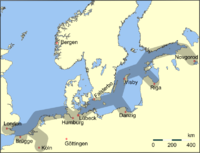
Saxon Quarter Baltic Quarter Westphalian
QuarterPrincipal Kontore Subsidiary Kontore Other cities Categories:- Cities in Saxony-Anhalt
- Magdeburg
- German state capitals
- Hanseatic League
- Martin Luther
- University towns in Germany
Wikimedia Foundation. 2010.

